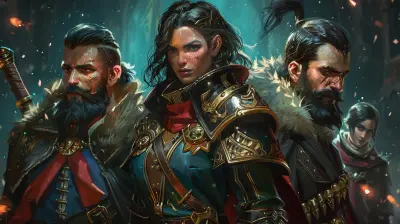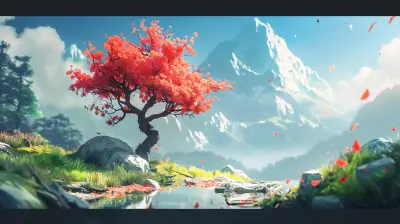The Rise of No-Code and Low-Code Tools in Game Development
3 October 2025
Game development used to be a realm reserved for those who could wrestle with lines of code, debug for hours, and understand complex software development kits. But now? That's changing—and fast.
Welcome to the era of no-code and low-code game development tools. Whether you're a budding game designer, an indie developer, or just someone with a great idea, these tools are lowering the barrier to entry and transforming the gaming landscape.
Let’s dive into how no-code and low-code tools are shaking things up, why they matter, and what they mean for the future of game development.
What Are No-Code and Low-Code Tools?
First off, let’s clear up what we’re talking about.- No-Code Tools: These platforms require zero programming. You design using drag-and-drop interfaces, visual scripting, and templates. Perfect for non-techies.
- Low-Code Tools: These do involve some coding, but far less than traditional development. Think of them as training wheels for developers—you still pedal, but the fall risk is lower.
Both options aim to make development easier, faster, and more accessible.
Why the Shift Toward No-Code and Low-Code Game Development?
Game development is no longer a gatekept club. The demand for games is sky-high across all platforms—mobile, desktop, browser, VR—you name it. Developers need faster ways to build, iterate, and release games.And here’s the kicker: not everyone creating games wants to be a coder.
With the rise of platforms like Roblox, Unity (with Playmaker), Construct, Buildbox, and GDevelop, creatives now have powerful tools to bring their ideas to life—without needing a computer science degree.
The Dream of Building Without Barriers
Think back to when you were a kid with a box of Legos. You didn’t need to know how to melt plastic or understand structural engineering. You just clicked pieces together and—boom—you had a spaceship.That’s the vibe with no-code game tools. They're the digital Legos of game development.
Imagine a graphic designer who’s always wanted to build a story-driven platformer. Instead of spending months learning C
or Unity from scratch, they can hop on GDevelop, drag in some artwork, set rules visually, and—voilà—they’ve got a prototype.
The Democratization of Game Creation
This is huge—really, it is. No-code and low-code tools are democratizing game development.Here’s how:
- Access to All: Anyone with a computer and an idea can now make games.- Faster Development Cycles: Game creators can rapidly prototype and launch.
- Lower Costs: Independent devs don’t need to hire coders or big teams.
- Creative Freedom: Artists, storytellers, and musicians can lead projects without being dependent on programmers.
All of a sudden, games are being made by people from all walks of life: teachers, teenagers, hobbyists, retirees—you name it.
The Tools Making Waves
Let’s take a closer look at some of the most popular no-code and low-code platforms that are turning non-developers into game creators:1. GDevelop
- Completely free and open-source.- Drag-and-drop interface with visual events.
- Great for 2D game creation.
2. Construct 3
- Web-based and accessible from anywhere.- Strong community and built-in asset store.
- Focused on exporting to mobile and web.
3. Buildbox
- Super user-friendly and designed for mobile games.- Includes a ton of templates.
- Monetization and publishing built-in.
4. GameSalad
- Education-focused; popular with schools.- Simple drag-and-drop logic.
- Great for interactive learning games.
5. Unity (with Bolt or Playmaker)
- Unity itself is a full-featured engine, but when paired with these visual scripting tools, becomes low-code.- Flexibility with advanced features still accessible for coders.
Who's Using These Tools?
You’d be surprised. Some of the most successful indie games started with no-code or low-code tools.Creators on platforms like itch.io and the App Store have released games built with GDevelop or Buildbox that have racked up thousands of downloads. And in schools, teachers are using platforms like GameSalad to help students create educational games—without teaching them how to code (yet).
Even businesses are jumping on board, making training or simulation games for employees using these tools.
Breaking Down the Benefits
So why are these platforms gaining so much traction? Let’s spell it out.1. Speed is Everything
Rapid development cycles are gold. No-code and low-code lets you move from idea to prototype sometimes in just hours.2. Creative Empowerment
You don’t need to rely on a dev team. If you’re a storyteller, designer, or musician—you can make your own magic.3. Community Support
Most platforms have huge user forums, template sharing, and tutorials. You're never really building alone.4. Cost-Effective
Avoid the high price tag of hiring developers or purchasing expensive software licenses.5. Cross-Platform Publishing
Many tools handle the heavy lifting when it comes to exporting your game across devices and operating systems.The Limitations (Because Nothing’s Perfect)
Of course, it’s not all sunshine and double jumps.1. Performance
Some no-code tools might struggle when it comes to complex physics or large games. You trade depth for speed and ease.2. Customization
If you want to do super niche stuff, you might hit a wall without diving into code.3. Scalability
Building a casual mobile game? Perfect. Creating a high-end multiplayer FPS? Ehhh… not quite.4. Ownership and Portability
Some platforms lock you into their ecosystem. Make sure to check who really “owns” your exported game and assets.Combining Code and No-Code: The Hybrid Future
Here’s the thing—no-code isn't here to kill coding. Low-code and no-code tools are most powerful when used alongside traditional development.Think of it like cooking. No-code is your instant pot—fast and easy. But sometimes, you’ll still want to use a stovetop for the full gourmet experience.
Even pro devs are using no-code tools to prototype faster, test mechanics, or collaborate with non-technical team members. It’s all about working smarter, not harder.
What This Means for Aspiring Game Developers
If you’ve ever dreamed of creating a game but felt overwhelmed by the complexity of coding, now’s your moment.You don’t need to be a tech genius. You need creativity, curiosity, and some coffee (seriously, game design is exhausting—but fun).
Start small. Build a mini-game. Test it. Share it. Iterate. Who knows? That simple idea could become the next mobile hit or viral indie darling.
The Future of Game Development
Let’s look ahead.In the next few years, expect:
- AI-powered assistants in no-code platforms that help design levels, write stories, or balance gameplay.
- More immersive drag-and-drop editors with real-time previews and multiplayer options.
- Integration with AR and VR tools to make immersive worlds more accessible.
- Broader educational use, introducing game development to students at an even earlier age.
The gate is wide open. Game development is no longer just a technical endeavor—it’s an art form, and artists are finally getting the tools they need.
Final Thoughts
The rise of no-code and low-code tools in game development isn't just a tech trend—it’s a creative revolution.It's about inclusion, imagination, and innovation. Whether you're an artist, teacher, hobbyist, or someone staring at a napkin sketch of your dream game, these tools are your ticket to bringing it to life.
So, what's stopping you?
Why not give it a shot and become a game creator today?
all images in this post were generated using AI tools
Category:
Game DevelopmentAuthor:

Francesca West
Discussion
rate this article
1 comments
Lisette Snow
Exciting times ahead! No-code and low-code tools make game development accessible for everyone—let's create magic!
October 4, 2025 at 5:00 PM

Francesca West
Absolutely! The democratization of game development through no-code and low-code tools is inspiring creativity like never before. Let's see what magic we can create together!


